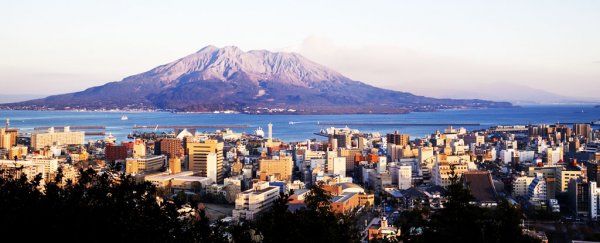One of Japan's most active volcanoes is edging closer to its next major eruption, scientists say, after new research detected an accelerated build-up of magma inside Mount Sakurajima.
The findings suggest that the volcano poses a significant threat to the neighbouring city of Kagoshima, with a violent eruption expected to occur some time in the next 25 or so years.
The coastal city, with a current population of more than 600,000 people, last suffered the consequences of a major Sakurajima eruption in 1914. That blast killed 58 people, and ranked as the most powerful volcanic eruption in Japan during the 20th century.
Now, according to an international team of researchers, conditions inside the volcano mean we're getting closer to a repeat performance.
The scientists, led by geophysical volcanologist James Hickey from the University of Exeter in the UK, studied surface deformation in and around the Aira caldera – a huge volcanic crater that acts as a kind of 'magma storage zone' for Mount Sakurajima, feeding the volcano with super-hot molten and semi-molten rock.
Surface measurements of the Aira caldera since the 1914 eruption indicate that the whole crater has been slowly lifting up.
Using GPS readings and computer modelling, Hickey's team was able to characterise the magma build-up occurring inside the caldera, reconstructing how this volcanic 'plumbing system' is feeding Sakurajima.
"What we have discovered is not just how the magma flows into the reservoir, but just how great the reservoir is becoming," says Hickey. "We believe that this new approach could help to improve eruption forecasting and hazard assessment at volcanoes not just in this area, but worldwide."
According to their calculations, Sakurajima is receiving approximately 14 million cubic metres (494 million cubic feet) of magma each year, which the researchers say equates to roughly 3.5 times the volume of Wembley Stadium in the UK. If you're not familiar with Wembley, let's just say it's one of the biggest stadiums in the world.
So that's an awful lot of hot rock being pumped into Sakurajima. And it's more than the volcano is capable of releasing in its regular mini eruptions – called Vulcanian eruptions – which occur on a daily basis, but aren't for the most part dangerous (unless you're standing too close, that is).
The upshot is that this increasing build-up suggests something's got to give, with another major eruption predicted in the next few decades.
"The 1914 eruption measured about 1.5 kilometres cubed in volume – a massive event," says Hickey. "From our data we think it would take around 130 years for the volcano to store the same amount of magma for another eruption of a similar size – meaning we are around 25 years away."
While the latest assessment must no doubt come as grim tidings to Kagoshima's residents, the good news is that these new techniques should ultimately make it easier to estimate when huge volcanic explosions are likely to arrive – hopefully giving city authorities sufficient notice to plan evacuations well in advance and head off any potential disasters.
"By identifying a timeframe over which we may see an increase in the level of activity at the volcano our colleagues at the Sakurajima volcano research centre can plan accordingly," says Hickey.
"We know that being forewarned means we are forearmed and providing essential information for local authorities who can potentially help save lives if an eruption was imminent."
The findings have been published in Scientific Reports.
